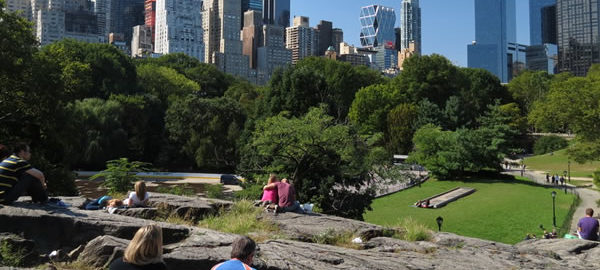Central Park is a magnificent piece of architecture – parkitecture, if you will – for make no mistake, the 843-acre landmark is man-made, constructed in 1858-1873. It was designed by Frederick Law Olmsted and Calvert Vaux, the same team that later designed Brooklyn’s Prospect Park. You could easily take a week or two to explore all of Central Park’s nooks and crannies – there are close to 200 named attractions within the park.
While it may seem strange that a park should be engineered, there is method to the madness. For example, entrance paths were laid out with sharp turns so that a screen of trees was quickly placed between the visitor and the city. Cross-park traverses at 66th, 79th, 85th and 97th Streets were sunk below grade level to make them disappear into the landscape.
This “Grand Tour” of 100+ slides covers the high points – but we’ll need several installments to really show the entire park. You may be interested in the companion gallery, focusing on Bethesda Fountain.
You may also be interested in learning more about Central Park from Central Park Conservancy, the private non-profit group that maintains the park in cooperation with New York City. Visit their site at www.centralparknyc.org.
Enjoy!
Getting There: Central Park is surrounded by 15 subway stations: N, R, and Q at Fifth Avenue/59th Street; A, B, C, D, and 1 at Columbus Circle; B and C along Central Park West at 72nd, 81st, 96th, 103rd and 110th Streets; 2 and 3 at Lenox Avenue/ 110th Street; 4, 5, and 6 along Lexington Avenue at 59th, 68th, 77th, 86th, 96th, 103rd and 110th Streets (walk 3 blocks west). Paths are NOT well marked. If you want to explore, you really need a detailed map! Make The Dairy/Visitor Center your first stop. It’s just south of the 65th Street Transverse, about midway through the park.
Google Map

![IMG_3118_19_20Adjust [3/7/2012 4:12:16 PM] IMG_3118_19_20Adjust [3/7/2012 4:12:16 PM]](https://www.newyorkitecture.com/wp-content/gallery/battery-park-city/img_3118_19_20adjust.jpg)

![IMG_5710 [11/1/2011 2:24:48 PM] IMG_5710 [11/1/2011 2:24:48 PM]](https://www.newyorkitecture.com/wp-content/gallery/astor-place-and-vicinity/IMG_5710.jpg)
![A_5729 [11/2/2011 8:28:48 AM] A_5729 [11/2/2011 8:28:48 AM]](https://www.newyorkitecture.com/wp-content/gallery/astor-place-and-vicinity/A_5729.jpg)

![IMG_5992_3_4Adjust [3/14/2012 2:30:07 PM] IMG_5992_3_4Adjust [3/14/2012 2:30:07 PM]](https://www.newyorkitecture.com/wp-content/gallery/new-york-is-looking-up/img_5992_3_4adjust.jpg)
![IMG_5995_6_7Adjust [3/14/2012 2:30:50 PM] IMG_5995_6_7Adjust [3/14/2012 2:30:50 PM]](https://www.newyorkitecture.com/wp-content/gallery/new-york-is-looking-up/img_5995_6_7adjust.jpg)
![IMG_09844_5_6Adjust [2/18/2012 1:39:07 PM] IMG_09844_5_6Adjust [2/18/2012 1:39:07 PM]](https://www.newyorkitecture.com/wp-content/gallery/new-york-is-looking-up/img_09844_5_6adjust.jpg)
![IMG_1699_700_701Adjust [2/27/2012 12:35:32 PM] IMG_1699_700_701Adjust [2/27/2012 12:35:32 PM]](https://www.newyorkitecture.com/wp-content/gallery/new-york-is-looking-up/img_1699_700_701adjust.jpg)
![IMG_0220_1_2Adjust [2/19/2012 12:14:37 PM] IMG_0220_1_2Adjust [2/19/2012 12:14:37 PM]](https://www.newyorkitecture.com/wp-content/gallery/new-york-is-looking-up/img_0220_1_2adjust.jpg)
![IMG_3856_7_8Adjust [3/9/2012 2:05:23 PM] IMG_3856_7_8Adjust [3/9/2012 2:05:23 PM]](https://www.newyorkitecture.com/wp-content/gallery/new-york-is-looking-up/img_3856_7_8adjust.jpg)
![IMG_3865_6_7Adjust [3/9/2012 2:06:51 PM] IMG_3865_6_7Adjust [3/9/2012 2:06:51 PM]](https://www.newyorkitecture.com/wp-content/gallery/new-york-is-looking-up/img_3865_6_7adjust.jpg)
![IMG_3889_90_91Adjust [3/9/2012 2:13:10 PM] IMG_3889_90_91Adjust [3/9/2012 2:13:10 PM]](https://www.newyorkitecture.com/wp-content/gallery/new-york-is-looking-up/img_3889_90_91adjust.jpg)






![IMG_7208 [11/3/2011 11:41:02 AM] IMG_7208 [11/3/2011 11:41:02 AM]](https://www.newyorkitecture.com/wp-content/gallery/septuagesimo-uno/IMG_7208.jpg)
